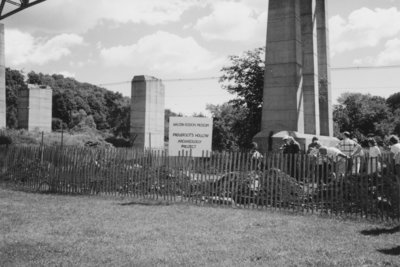Proudfoot's Hollow Archaeology Project, 1989, Halton Region Museum
Description
- Media Type
- Image
- Text
- Item Type
- Photographs
- Description
- This archaeological excavation investigated the nineteenth century community of Proudfoot’s Hollow, at the intersection of the Sixteen Mile Creek with the Dundas Highway (now Dundas Street). The excavation was sponsored by the Halton Region Museum and conducted by John R. Triggs for two weeks from 21-31 August 1989. The purpose of the project was to determine the potential of the site as the setting for a proposed archaeological field school program scheduled for the summer of 1990. Unfortunately, funding fell through and as far as is known, no field school took place.
The 1989 excavation consisted of two phases. Phase 1 consisted of a systematic search of all historic documents relating to the community. This stage entailed archival and library research and its end objective was to develop a historic profile of Proudfoot's Hollow by documenting the growth and decline of the community throughout the nineteenth century.
Phase 2 was based on the results of Phase 1. An excavation was carried out to assess the potential of the site for the archaeological field school program. A total of 14 square metres was stratigraphically excavated and two architectural features belonging to a multistoried structure together with several hundred associated artifacts were recovered and are currently housed at the Halton Region Museum. Evidence indicated that the structure dates to the mid-nineteenth century and clearly related to the occupation of the village. The archaeologist compared Proudfoot’s Hollow with the nearby Dorland site, contemporary with the Hollow, which offered insight into life of the nineteenth century rural homestead as compared to the thriving mill town.
The old settlement actually predates Proudfoot's Hollow. George Chalmers, a Scot, had started as a general merchant at Munn's Corners about 1820. In 1826 he began to buy up land along The Sixteen at the Dundas Highway. His saw and grist mill at Dundas and The Sixteen Mile Creek was just north west of the Triller family property on the east bank. Chalmer's mill went into operation in 1827. The Sixteen Village, also known as the Sixteen Hollow, grew up around it.
In 1840, Chalmers fell into financial difficulty and the mill with its surrounding buildings was sold to John Proudfoot who named the mill "Trafalgar". The village was then called Proudfoot's Hollow. - Notes
- The citation of the Report is: Proudfoot’s Hollow (AiGw-203) August 1989 excavation, archaeologist John R. Triggs (license #89-198c). The archives of the Trafalgar Township Historical Society has a print copy of the report.
- Inscriptions
- Halton Region Museum Proudfoot's Hollow Archaeology Project
- Date of Original
- August 1989
- Date Of Event
- 1989
- Subject(s)
- Personal Name(s)
- George Chalmers. John Proudfoot. John r. Triggs.
- Local identifier
- TTADM000134
- Collection
- Trafalgar Township Historical Society
- Language of Item
- English
- Geographic Coverage
-
-
Ontario, Canada
Latitude: 43.43341 Longitude: -79.66631
-
- Copyright Statement
- Copyright status unknown. Responsibility for determining the copyright status and any use rests exclusively with the user.
- Recommended Citation
- Proudfoot's Hollow Archaeology Project, 1980's, Halton Region Museum
- Contact
-
Trafalgar Township Historical Society Sponsor: Jeff Knoll, Local & Regional Councillor for Oakville Ward 5 – Town of Oakville/Regional Municipality of Halton


